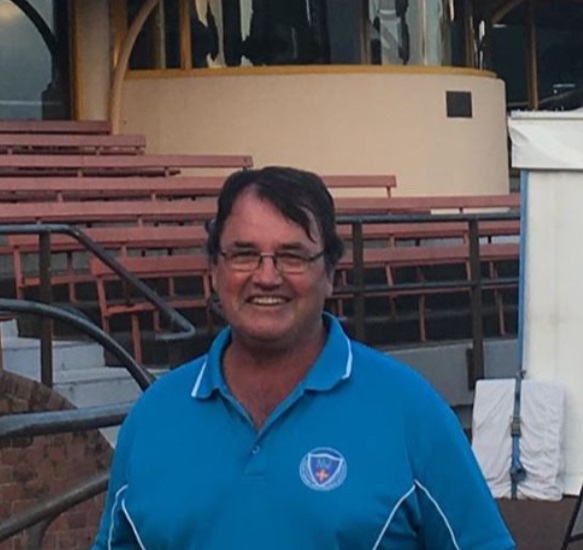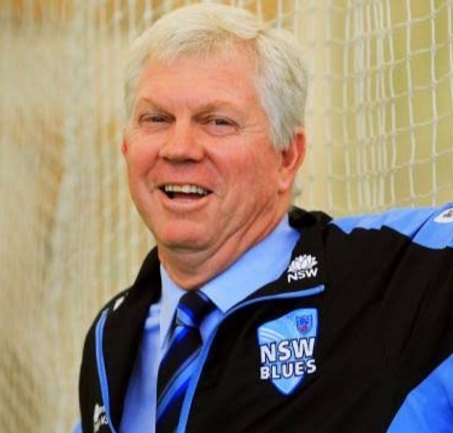About Me
Tim Ebbeck
Current Rating: 5 / 5
Company Director Ebbeck TIG Consulting
Central Coast, NSW, Australia
+61413803112
Partner Sponsors
My Activity
question
Q: I was still at school when I first met the great Neil Marks.
There was some discussion between my school principal at St Leo's College, the truly inspirational Brother Brian Berg, and Neil about whether I should be playing grade cricket or continuing to focus on school cricket. As much as I felt I let down Brother Berg, I decided to focus on grade cricket with the Club. I had always wanted to represent Northern District Cricket Club based at what was then known as Waitara Park, later known as Mark Taylor Oval.
What an education. I was blessed to have Brian Berg as a school principal and cricket mentor. He was the most brilliant school principal, an Australian Schoolboys selector and manager, rolled a terrific wicket at the school #1 oval himself, took the First X1 away for country trips and had us stay in a local pub and engage with the locals rather than be billeted out, and a wonderful advocate for the Western Suburbs District Cricket Club and the legendary Wally Welham which was challenging! Imagine that sort of leadership from a Christian Brother! But that was the wonderful Brian Berg. Education was about like experiences.
And then to have the privilege of spending so much time with Neil was just more priceless life experience
There was some discussion between my school principal at St Leo's College, the truly inspirational Brother Brian Berg, and Neil about whether I should be playing grade cricket or continuing to focus on school cricket. As much as I felt I let down Brother Berg, I decided to focus on grade cricket with the Club. I had always wanted to represent Northern District Cricket Club based at what was then known as Waitara Park, later known as Mark Taylor Oval.
What an education. I was blessed to have Brian Berg as a school principal and cricket mentor. He was the most brilliant school principal, an Australian Schoolboys selector and manager, rolled a terrific wicket at the school #1 oval himself, took the First X1 away for country trips and had us stay in a local pub and engage with the locals rather than be billeted out, and a wonderful advocate for the Western Suburbs District Cricket Club and the legendary Wally Welham which was challenging! Imagine that sort of leadership from a Christian Brother! But that was the wonderful Brian Berg. Education was about like experiences.
And then to have the privilege of spending so much time with Neil was just more priceless life experience
https://www.cricconnect.com/profile/113/tim-ebbeck/blog/1963/neil-marks-rip-old-mate-and-thank-you
blog post
I was still at school when I first met the great Neil Marks. There was some discussion between my school principal at St Leo's College, the truly inspirational Brother Brian Berg, and Neil ...
question
Q: I read Lyall Gardener’s recent story about a pitch being a little bit longer than it should have been and Len Pascoe bowling his heart out!
Great story by Lyall and “unfortunate” error of course!
It reminded me of a game I played back in the early 1980s featuring the same Len Pascoe and a young Mark Taylor.
Now, I may not get all my facts right in telling this story. So, if I’m out by a year or two, and exaggerate part of the story a bit, please cut me some slack. But the story is true! As Neil Marks once told me, “never let the facts get in the way of good story.”
As I said, it was the early 1980s and the game was between Bankstown and Northern District. It was being played at Sommerville Park as Waitara Park (later to be named “Mark Taylor Oval”, no doubt because of this story) was out of action. That means it was probably early in the season and the Rugby boys had messed up Waitara.
Great story by Lyall and “unfortunate” error of course!
It reminded me of a game I played back in the early 1980s featuring the same Len Pascoe and a young Mark Taylor.
Now, I may not get all my facts right in telling this story. So, if I’m out by a year or two, and exaggerate part of the story a bit, please cut me some slack. But the story is true! As Neil Marks once told me, “never let the facts get in the way of good story.”
As I said, it was the early 1980s and the game was between Bankstown and Northern District. It was being played at Sommerville Park as Waitara Park (later to be named “Mark Taylor Oval”, no doubt because of this story) was out of action. That means it was probably early in the season and the Rugby boys had messed up Waitara.
https://www.cricconnect.com/profile/113/tim-ebbeck/blog/505/lennie-v-tubby
question
Q: I have to admit that Boxing Day is MY DAY.
I mean that in the nicest possible way.
It’s not that I don’t like people.
I do like people.
Well, most people.
Not batsmen when they refused to get out.
Not fast bowlers when they made me dive down the leg side.
Not umpires when they make dud decisions. Arthur Watson came to mind with a certain leg side stumping about 4000 years ago.
But by and large I do like people.
But on Boxing Day my liking for people changes.
Because on Boxing Day I am watching the cricket.
Period.
It’s MY DAY.
Now, it doesn’t mean other people can’t join me.
They can.
They are not so much welcome as tolerated. They become welcome when they bring me a drink. In front of the TV.
Because I’m, watching the cricket.
There are 2 times during the day I become sociable for those not watching the cricket with me.
One lasts for 40 minutes. The other for 20 minutes.
And after the cricket is over, I become my old social self again.
But during playing hours, on MY DAY, I watch the cricket.
Even when my eyelids become heavy, I’m watching the cricket.
Boxing Day is MY DAY.
I mean that in the nicest possible way.
It’s not that I don’t like people.
I do like people.
Well, most people.
Not batsmen when they refused to get out.
Not fast bowlers when they made me dive down the leg side.
Not umpires when they make dud decisions. Arthur Watson came to mind with a certain leg side stumping about 4000 years ago.
But by and large I do like people.
But on Boxing Day my liking for people changes.
Because on Boxing Day I am watching the cricket.
Period.
It’s MY DAY.
Now, it doesn’t mean other people can’t join me.
They can.
They are not so much welcome as tolerated. They become welcome when they bring me a drink. In front of the TV.
Because I’m, watching the cricket.
There are 2 times during the day I become sociable for those not watching the cricket with me.
One lasts for 40 minutes. The other for 20 minutes.
And after the cricket is over, I become my old social self again.
But during playing hours, on MY DAY, I watch the cricket.
Even when my eyelids become heavy, I’m watching the cricket.
Boxing Day is MY DAY.
question
Q: I read the CricConnect on Steve Liggins with great fondness.
Liggo is one of those people you meet in life who was always true to themselves. And that approach was also the cause of one of the funniest things I’ve seen on a cricket field.
You see, Liggo was a big fast bowler.
You know the type.
They are the ones who are meant to be scary. Who eat raw meat before they bowl. Who love the sound of the ball hitting the batsmen. Who intimidate and like to be feared.
Now, there’s a school of thought out there that fast bowlers are not that smart.
Liggo is one of those people you meet in life who was always true to themselves. And that approach was also the cause of one of the funniest things I’ve seen on a cricket field.
You see, Liggo was a big fast bowler.
You know the type.
They are the ones who are meant to be scary. Who eat raw meat before they bowl. Who love the sound of the ball hitting the batsmen. Who intimidate and like to be feared.
Now, there’s a school of thought out there that fast bowlers are not that smart.
https://www.cricconnect.com/profile/113/tim-ebbeck/blog/267/stephen-liggins-man-of-goodness
answered
Q: We have a young wicket keeper in our club who moves really well to his left but struggles moving to his right. Last season he missed a few catches with the balls going between himself and first slip off right hander batters. He didn’t have the same problem with left hand batters.
Can we ask what training drill we could help him with leading into this season?
Can we ask what training drill we could help him with leading into this season?
A: A couple of thoughts. Firstly, have a confident mindset - go for catches, don't think, anticipate and go! It's about being positive and backing yourself. Secondly, really spend time in working with your first slipper and controlling the space. It's a feeling more than a formula. I had the privilege of standing next to 2 great slipper - Neil Howlett and Mark Taylor. In both cases, they took their lead off where I stood, not the other way around. And often I was looking for more space and would push them a little wider. It's also not just the width but how far behind you they are. Just find something that "feels" right. And feeling will come with practice. Thirdly, make practice FUN! Ross Edwards was captain at Northern District in Sydney during world series cricket and for a few years thereafter and was brilliant to practice with. Drills were always competitive and FUN! Especially slipper/keeper sessions. Never let criticism become a core practice drill - it's when practicing that you do experiment, and you learn your sweet spots. One important drill is to only catch with one hand. If there's a concern on the right hand side, practice only with the right hand quite a bit. I'm not a believer that you should go one handed in the first instance, but it's an important drill. Finally, footwork is CRITICAL. I always tried to be upright more than diving. Diving is a last resort. For example, I'd tend to go a little wider rather than more behind the stumps - the fact is, most balls are either going to go to the batsman or outside off. If they go outside off, you really want to be in a position where you are taking the ball on your left side (to a right hand batter) and if there's a nick it comes to you and if it's wider then you are already further out there to take a wider catch. Seriously, you'd also be surprised how well you can cover something that goes down the legside. Take catches standing up and dive to save byes! And practice hard whilst having lots of fun!
answered
Q: Batting first in front of a large crowd at Redfern Oval, this performance may best be summed up by the report which appeared in The Sunday Times newspaper on 1 February 1903. It read: “At Redfern, Victor Trumper provided 7,000 people with a display which even his greatest admirers were not prepared. In 2 ¾ hours, he compiled 335 runs off his own bat, his cricket and rate of scoring outclassing anything ever before seen on a ground noted for fast rungetting. Prior to Trumper, Redfern bowlers had been performing in fine style, but he simply annihilated them yesterday. He hit 22 fives and 39 fours, which made 266 runs by boundary hits. He sent the ball out of the ground and over the heads of the people in all directions, into the streets, the park, and the bowling green. Such hitting was never before seen here, and probably in the world. Trumper’s 335 is the record score for Senior cricket in Sydney and the first wicket partnership of 423 by him and D. Gee, who made 172, is also a record here. It may be mentioned that E. Hume, Redfern’s crack bowler, bowled ten overs from which 120 runs were hit.”
https://www.cricconnect.com/profile/227/lyall-gardner/blog/1265/nsw-premier-cricket-the-record-partnerships-from-1893-to-2023-the-first-wicket-record
A: Awesome story Lyall! Thanks for making the effort to share such a wonderful piece of history!
answered
Q: Carey stumps Bairstow and the Spirit of Cricket
In almost every game of cricket at any level around the world, you will see a wicket keeper standing back to the fast and medium pace bowlers. At some stage during an innings, the wicket keeper will take the ball the batter either let's go or misses and, in the same motion under arm it back towards the stumps in the hope the batter is out of their crease.
It's been happening since the game began and every wicket keeper, including all our favourite test keepers, have done it at some stage.
Why now, when Alex Carey, in the same motion, does it in a test match for Australia against England and Jonny Bairstow strangely walks out of his crease and is run out are some people so upset and screaming from the rooftops?
In almost every game of cricket at any level around the world, you will see a wicket keeper standing back to the fast and medium pace bowlers. At some stage during an innings, the wicket keeper will take the ball the batter either let's go or misses and, in the same motion under arm it back towards the stumps in the hope the batter is out of their crease.
It's been happening since the game began and every wicket keeper, including all our favourite test keepers, have done it at some stage.
Why now, when Alex Carey, in the same motion, does it in a test match for Australia against England and Jonny Bairstow strangely walks out of his crease and is run out are some people so upset and screaming from the rooftops?
https://www.cricconnect.com/profile/32/paul-ryan/blog/1241/carey-stumps-bairstow-and-the-spirit-of-cricket
A: As always, right on the ball Mr Ryan. I find it somewhat poignant that Bairstow was the victim. In a court of law my question to Johnny Bairstow would be: "So, explain this to me like I'm a 6 year old. When you are keeping and you are standing back to a quick bowler and you see a batsman wandering out of his crease, you try to stump him by throwing the ball at the stumps, correct? YES, THAT IS CORRECT. So, when you are batting does it ever cross your mind that the opposing keeper might do the same thing? I GUESS I'D NEVER THOUGHT ABOUT IT THAT WAY. I rest my case your honour." You know what I hate about winnng an Ashes Test? NOTHING!
question
Q: NSW Combined Catholic Colleges cricket team - 1978
Back Row – M. M’Darcy (Manager), C. Hines, D.Gilbert, M. Appleton, D. Palmer, S. Irwin (Vice Captain), P. Coyte
Front Row – T. Gahan, T. Ebbeck, M. Carmichael (Captain), M. McMahon, J. Dixon
Absent – T. McMahon
Back Row – M. M’Darcy (Manager), C. Hines, D.Gilbert, M. Appleton, D. Palmer, S. Irwin (Vice Captain), P. Coyte
Front Row – T. Gahan, T. Ebbeck, M. Carmichael (Captain), M. McMahon, J. Dixon
Absent – T. McMahon
answered
Q: The following were my guiding principles as a wicket keeper
1. The nuts and bolts - footwork and hands. Hard work to develop technique and fitness that will stand up under pressure and tiredness both up to the stumps and back.
2. Run the fielding standard, set the example, and expect standards from the team.
3. Be the captain’s and bowler’s aid - field setting, bowling changes, ideas, advice.
4. Be a good team man and always be involved in the group activities.
5. Work harder than everyone else. Only one of you so the position deserves respect if you want to keep it.
1. The nuts and bolts - footwork and hands. Hard work to develop technique and fitness that will stand up under pressure and tiredness both up to the stumps and back.
2. Run the fielding standard, set the example, and expect standards from the team.
3. Be the captain’s and bowler’s aid - field setting, bowling changes, ideas, advice.
4. Be a good team man and always be involved in the group activities.
5. Work harder than everyone else. Only one of you so the position deserves respect if you want to keep it.
A: The three aspects I always thought formed part of the keepers role were:
1. Being a team player
2. Elite Athlete
3. Motivator
1. Being a team player
2. Elite Athlete
3. Motivator
question
Q: As a wicket keeper my favourite moments were ones of pure joy when my feet were moving, my hands were soft, my talk was positive, and my mates were working hard and together.
My favourite story was in the 1986/87 grand final against Campbelltown and we were turning the game around with our bowling and fielding. English Test cricketer Derek Pringle came to the crease and Steve Whitfield was bowling. Earlier that season, Whit had twice got Derek out caught behind with his wonderful arm ball. I waited for Derek to settle down and take guard and then stood up and said to Whit “Whit, he’s here, remember THE ball?” Whit looked down the wicket and nodded.
As Whit was just about to start his approach I stood up again and said “Whit, remember precisely where that ball needs to go?” Whit acknowledged me again.
That wonderful umpire, Dick French, put his arm out and said “Timmy, that’s enough.” I smiled at Dick with that charming smile most people never acknowledged and went back in my stance. Whit pitched the ball precisely on off stump and the arm ball took the edge. Derek was 3 golden ducks from a Whitfield arm ball caught Ebbeck in the one season. Brilliant.
My favourite story was in the 1986/87 grand final against Campbelltown and we were turning the game around with our bowling and fielding. English Test cricketer Derek Pringle came to the crease and Steve Whitfield was bowling. Earlier that season, Whit had twice got Derek out caught behind with his wonderful arm ball. I waited for Derek to settle down and take guard and then stood up and said to Whit “Whit, he’s here, remember THE ball?” Whit looked down the wicket and nodded.
As Whit was just about to start his approach I stood up again and said “Whit, remember precisely where that ball needs to go?” Whit acknowledged me again.
That wonderful umpire, Dick French, put his arm out and said “Timmy, that’s enough.” I smiled at Dick with that charming smile most people never acknowledged and went back in my stance. Whit pitched the ball precisely on off stump and the arm ball took the edge. Derek was 3 golden ducks from a Whitfield arm ball caught Ebbeck in the one season. Brilliant.
question
Q: I was a wicket keeper and loved being in the action all the time. I wrote an overview on my LinkedIn profile a few years ago which described how what I learned as a wicket-keeper shaped me in my business career:
“For years I was the wicket keeper in a cricket team , a role that shapes how the team performs. It taught me the virtue of humility, the importance of teamwork and reliability, and the value that comes from instinct.
The wicket keeper is many things: the enforcer who takes the game to the competition, the elite fielder who’s able to convert half-chances into chances, and a safe set of hands who has the experience to be in the right place at the right time.
Like any successful person, a good wicket keeper is consistent day in and day out. He is never off duty mentally or physically.
What I learned behind the stumps shaped my approach to leadership.”
“For years I was the wicket keeper in a cricket team , a role that shapes how the team performs. It taught me the virtue of humility, the importance of teamwork and reliability, and the value that comes from instinct.
The wicket keeper is many things: the enforcer who takes the game to the competition, the elite fielder who’s able to convert half-chances into chances, and a safe set of hands who has the experience to be in the right place at the right time.
Like any successful person, a good wicket keeper is consistent day in and day out. He is never off duty mentally or physically.
What I learned behind the stumps shaped my approach to leadership.”
answered
Q: As a baseball catcher I’d like to ask about the relationship between the bowlers in cricket and the wicket keeper.
Baseball catchers offer signals to the pitcher so we know what pitches will be thrown. Do wicket keepers do the same as I can’t seem to pick up any.
How does the wicket keeper know what the bowler is going to bowl?
Baseball catchers offer signals to the pitcher so we know what pitches will be thrown. Do wicket keepers do the same as I can’t seem to pick up any.
How does the wicket keeper know what the bowler is going to bowl?
A: Great question Toby. Maybe signals are used in junior cricket but at a senior level, the keeper will know what the bowler is bowling without signals. They spend a huge amount of time together and also talk a great deal on the field. It's less about signals and more about planning strategies around specific batsmen. But the keeper should be able to read the bowler without signals.
answered
Q: We have a difficult selection decision to make going into our season about our wicket keeper.
One of our top order bats (averaged 38 last season) keeps ok but is prone to a few mistakes a game especially to our spinners whereas we have a really good keeper who hardly makes a mistake but only averaged 16 with the bat and bats around number 8.
What our people’s thoughts on who to choose?
One of our top order bats (averaged 38 last season) keeps ok but is prone to a few mistakes a game especially to our spinners whereas we have a really good keeper who hardly makes a mistake but only averaged 16 with the bat and bats around number 8.
What our people’s thoughts on who to choose?
A: Agree with Scott 100%. Your keeper has 4 key roles. 1. Be the best and most elite fielder in your team. 2. Support the bowlers brilliantly. 3. Lead the team morale and motivation, and occasionally be the enforcer. 4. Be a member of the batting line-up and contribute. If you need to pick a less-talented keeper because you need runs, then look at your top 6 batters and question whether they are pulling their weight. The likes of Gilly are unique. And even he batted 7 in tests. Pick your best keeper. Always.
question
Q: So I tried AI to tell me what are the parallels between life and cricket. Here's what it came up with: Cricket is a game of skill, strategy and patience. It is also a game of uncertainty, unpredictability and frustration. Life is like cricket in many ways. You never know what kind of pitch you will get, what kind of ball you will face, or what kind of umpire you will encounter. You have to adapt to the changing conditions, play according to your strengths and weaknesses, and hope for the best. Sometimes you hit a six, sometimes you get out for a duck. Sometimes you win the toss, sometimes you lose it. Sometimes you catch a brilliant catch, sometimes you drop a sitter. Sometimes you get a fair decision, sometimes you get a howler. The only thing that matters is how you handle the ups and downs, how you celebrate the victories and learn from the defeats, how you respect your opponents and enjoy the game. Cricket teaches us many lessons about life: teamwork, discipline, perseverance, sportsmanship and humility. Cricket is not just a sport; it is a way of life.
answered
Q: How important is the relationship between a spinner and their wicket keeper?
A: Critical. Let's face it. The bowler is the one who does the really hard work here. I say that as a wicket keeper acknowledging that our job is to support the bowler (in no way do I understate the importance of the keeper but making the point that the bowler has a very difficult job). The bowler needs to TRUST and have CONFIDENCE in the keeper. It is therefore a special relationship. I had the privilege of keeping to 2 amazing spinners when I was playing in Steve Whitfield and Peter Taylor who often bowled in tandem. They needed to be able to have confidence to bowl to their plan with real confidence that i was 100% aligned to the plan and was able to support them, and execute my part. Same with the slips (it helped we had Mark Taylor and Neil Howlett in slips!). CONFIDENCE comes from TRUSTING the keeper and also leads to the discussions that the keeper can have with the spin bowler about potential changes to their game plan based on what the keeper is seeing. And let's not forget the noise the keeper makes to support the bowler. I have to say that I still hug all my bowlers every time i see them even after all the years have passed because I feel a special bond with them.
answered
Q: If a wicket keeper has the skills and confidence to stand over the stumps to a slow medium pace bowler to create more chances for the team but the bowler doesn’t want like it, should the keeper persist or stay back?
A: I agree with Scott Atkinson. I think there are stages in a game where it is a great tactical move to put pressure on and potentially create a wicket. I only ever once had a bowler express concern but admittedly he was an opening bowler but he was not a fast bowler and really wasn't penetrating. His ego was a challenge! :-) Communication and alignment on objective are the key!
blog post
I recently wrote about how fast bowlers swear a lot.And it made me think about a former ND’s player – let’s call him Bobby.Bobby played a lot of cricket for the club and was par ...
blog post
Back Row – M. M’Darcy (Manager), C. Hines, D.Gilbert, M. Appleton, D. Palmer, S. Irwin (Vice Captain), P. CoyteFront Row – T. Gahan, T. Ebbeck, M. Carmichael (Captain), M. McMahon, J. ...


































